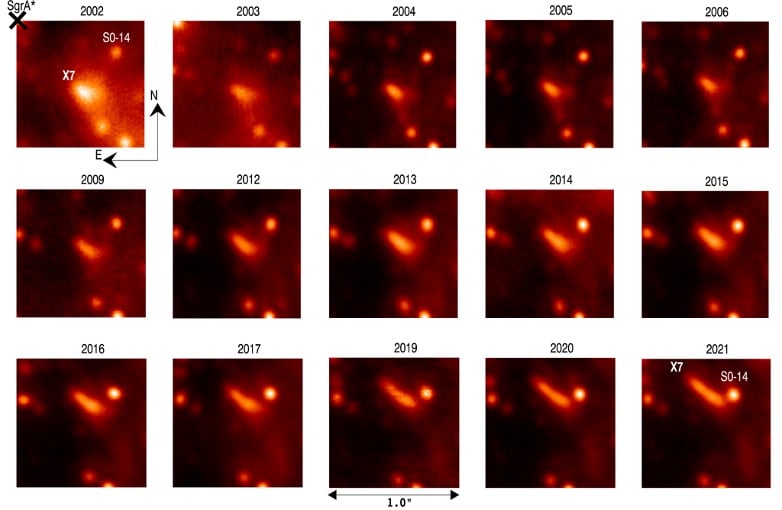
Supermassive black hole in Milky Way destroys dust cloud 50 times larger than Earth
A supermassive black hole at the centre of the Milky Way is tearing up and destroying a huge dust cloud 3,000 times the distance between the Sun and Earth, Space.com reports.
The dust cloud, called X7 and 50 times the mass of Earth, orbits around the supermassive black hole in our galaxy called Sagittarius A*. For the past 20 years, astronomers have been tracking the journey of this dust cloud using W. M. Keck Observatory, located on the island of Mauna Kea in Hawaii, is one of the most powerful telescopes in the world.
Observations have revealed that the dust cloud has been gradually stretched as it wraps around a black hole, reaching a length 3000 times greater than the distance between the Sun and Earth.
An observing campaign launched in 2002 is providing new insights into the processes controlled by Sagittarius A*'s powerful gravitational forces.
“This is a unique opportunity to observe the effects of black hole tidal forces at high resolution, allowing us to understand the extreme conditions at the centre of the galaxy,” said lead author Anna Ciurlo of the University of California Los Angeles.
Astronomers studied X7 using the observatory's NIRC2 instrument, which shows the universe in the near-infrared light, like NASA's James Webb Space Telescope. Thanks to the ability of infrared light to penetrate dust, scientists were able to study the motion of the dust cloud in great detail and found that it currently orbits the centre of the galaxy in about 170 years. Scientists calculate that the dust cloud will get as close to the black hole as possible in 2036, and the cloud will disappear completely shortly after that.

“It's exciting to see significant changes in the shape and dynamics of x7 occur in such minute detail and in such a relatively short period of time before the gravitational forces of the supermassive black hole at the centre of the Milky Way affect the object,” said study co-author Randy Campbell.
After the demise of the dust cloud, the black hole will absorb its material. Scientists say there could be some fireworks during this process as the dust begins to heat up before it even crosses the event horizon.
Although researchers have predicted the future of the dust cloud, they know very little about its past. They believe the cloud could have formed as a result of dust and gas being ejected during the merger of two stars.
“One possibility is that X7 gas and dust was ejected during the merger of two stars. In this process, the merged star hides in a shell of dust and gas, and the ejected gas could have created objects such as X7,” said Anna Ciurlo.
X7 is one of many dust clouds that exist at the centre of the Milky Way. They are called G-objects, which orbit a black hole very quickly, at speeds of up to 790km per second. Insights about X7 could help astronomers make predictions about other G objects.
The study was published in the Astrophysical Journal.
- Related News
- The end of the Universe: 3 plausible theories of a global apocalypse
- Mutated bacteria resistant to drugs found on the ISS: What does this mean and why is it a problem?
- 4 flares erupted from Sun in rare event: the Earth may be hit by geomagnetic storm (video)
- 11 incredible satellite photos published on Earth Day
- NASA shows all of Ingenuity's flight trajectories in one video
- Could life exist on Saturn's moon Enceladus?
- Most read
month
week
day
- How DNA analysis helps to solve crimes and who can sell your DNA data and why: Interview with former FBI scientist Bruce Budowle 793
- Huge battery, IP68/IP69K and MIL-STD-810H certifications: Ulefone will present the Armor Pad 3 Pro tablet (photo) 779
- 5 original buildings with curious optical illusions (photos) 627
- How will new technologies change future of finance? Interview with director of Apricot Capital (video) 617
- What risks do crypto and digital currencies pose? Interview with Rasmus Nielsen 615
- Metal roofs: What makes them a great choice for small homes? 604
- WhatsApp will get new and useful feature 566
- 4 flares erupted from Sun in rare event: the Earth may be hit by geomagnetic storm (video) 535
- Android 15 to get two useful new features 520
- Mutated bacteria resistant to drugs found on the ISS: What does this mean and why is it a problem? 517
- Archive
